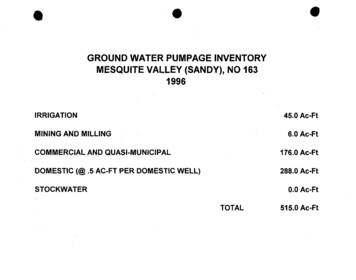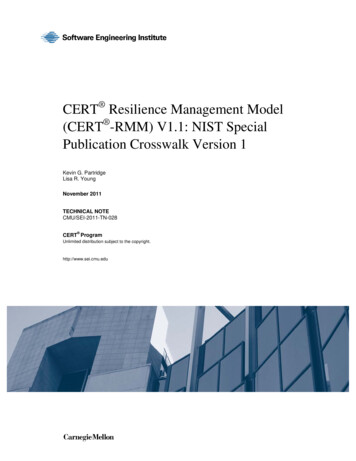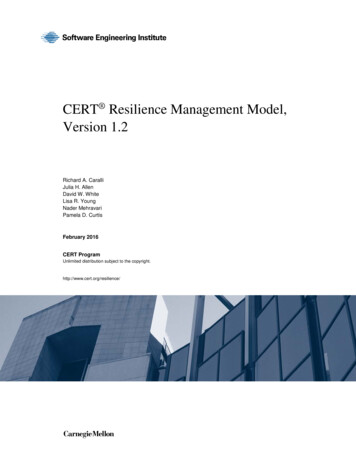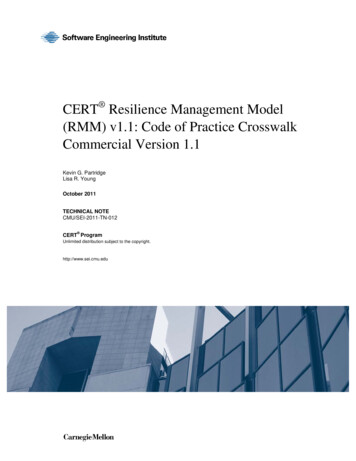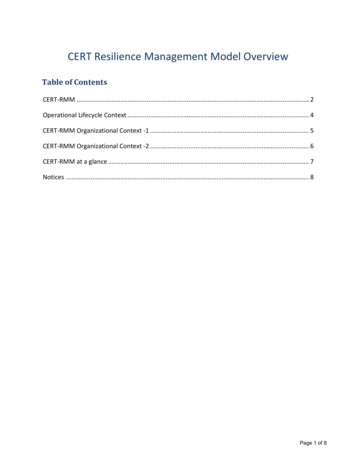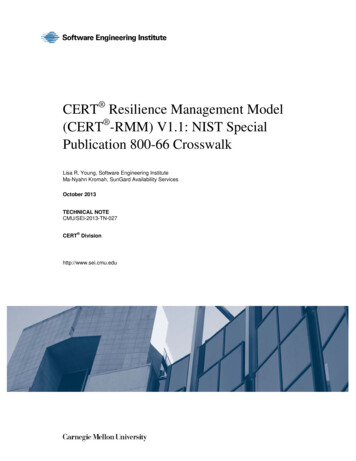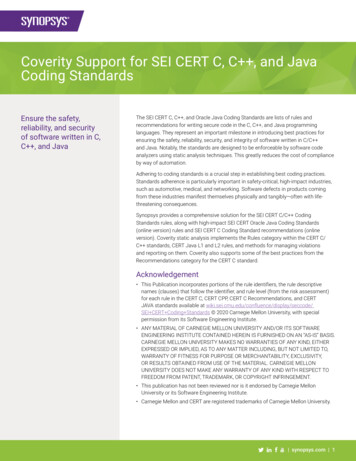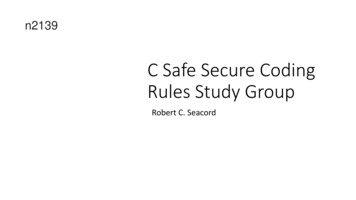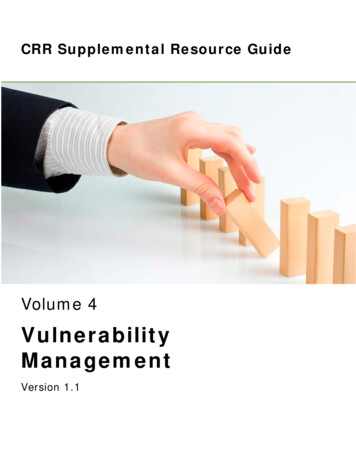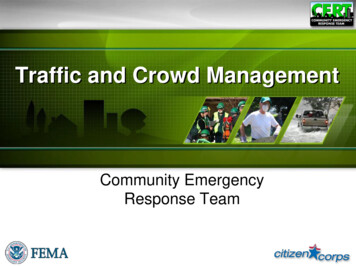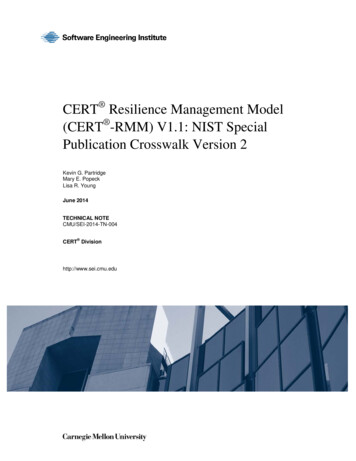
Transcription
CERT Resilience Management Model,Version 1.0Improving Operational Resilience ProcessesRichard A. CaralliJulia H. AllenPamela D. CurtisDavid W. WhiteLisa R. YoungMay 2010TECHNICAL REPORTCMU/SEI-2010-TR-012ESC-TR-2010-012CERT ProgramUnlimited distribution subject to the copyright.http:// www.cert.org/resilience/
This report was prepared for theSEI Administrative AgentESC/XPK5 Eglin StreetHanscom AFB, MA 01731-2100The ideas and findings in this report should not be construed as an official DoD position. It is published in theinterest of scientific and technical information exchange.This work is sponsored by the U.S. Department of Defense. The Software Engineering Institute is a federallyfunded research and development center sponsored by the U.S. Department of Defense.Copyright 2010 Carnegie Mellon University.NO WARRANTYTHIS CARNEGIE MELLON UNIVERSITY AND SOFTWARE ENGINEERING INSTITUTE MATERIAL ISFURNISHED ON AN “AS-IS” BASIS. CARNEGIE MELLON UNIVERSITY MAKES NO WARRANTIES OFANY KIND, EITHER EXPRESSED OR IMPLIED, AS TO ANY MATTER INCLUDING, BUT NOT LIMITEDTO, WARRANTY OF FITNESS FOR PURPOSE OR MERCHANTABILITY, EXCLUSIVITY, OR RESULTSOBTAINED FROM USE OF THE MATERIAL. CARNEGIE MELLON UNIVERSITY DOES NOT MAKEANY WARRANTY OF ANY KIND WITH RESPECT TO FREEDOM FROM PATENT, TRADEMARK, ORCOPYRIGHT INFRINGEMENT.Use of any trademarks in this report is not intended in any way to infringe on the rights of the trademark holder.Internal use. Permission to reproduce this document and to prepare derivative works from this document forinternal use is granted, provided the copyright and “No Warranty” statements are included with all reproductionsand derivative works.External use. This document may be reproduced in its entirety, without modification, and freely distributed inwritten or electronic form without requesting formal permission. Permission is required for any other externaland/or commercial use. Requests for permission should be directed to the Software Engineering Institute atpermission@sei.cmu.edu.This work was created in the performance of Federal Government Contract Number FA8721-05-C-0003 withCarnegie Mellon University for the operation of the Software Engineering Institute, a federally funded researchand development center. The Government of the United States has a royalty-free government-purpose license touse, duplicate, or disclose the work, in whole or in part and in any manner, and to have or permit others to do so,for government purposes pursuant to the copyright license under the clause at 252.227-7013.
Table of ContentsPrefaceviAbstractx Part One: About the CERT Resilience Management Model11Introduction1.1 The Influence of Process Improvement and Capability Maturity Models1.2 The Evolution of CERT-RMM1.3 CERT-RMM1.4 CERT-RMM and CMMI Models1.5 Why CERT-RMM Is Not a Capability Maturity Model345710122Understanding Key Concepts in CERT-RMM2.1 Foundational Concepts151532.22.1.1 Disruption and Stress2.1.2 Convergence2.1.3 Managing Operational ResilienceElements of Operational Resilience Management151718192.32.2.1 Services2.2.2 Business Processes2.2.3 Assets2.2.4 Resilience Requirements2.2.5 Strategies for Protecting and Sustaining Assets2.2.6 Life-Cycle CoverageAdapting CERT-RMM Terminology and Concepts20222225262730Model Components3.1 The Process Areas and Their Categories3.23.1.1 Process Area IconsProcess Area Component Categories32323.33.2.1 Required Components3.2.2 Expected Components3.2.3 Informative ComponentsProcess Area Component 3.3.73.3.8343434343435363.43.543131Purpose StatementsIntroductory NotesRelated Process Areas SectionSummary of Specific Goals and PracticesSpecific Goals and PracticesGeneric Goals and PracticesTypical Work ProductsSubpractices, Notes, Example Blocks, Generic Practice Elaborations,References, and AmplificationsNumbering SchemeTypographical and Structural ConventionsModel Relationships4.1 The Model View4.1.1Enterprise Managementi CMU/SEI-2010-TR-012363738414142
4.2Objective Views for Assets46Part Two: Process Institutionalization and Improvement515525252546Institutionalizing Operational Resilience Management Processes5.1 Overview5.2 Understanding Capability Levels5.3 Connecting Capability Levels to Process Institutionalization5.45.3.1 Capability Level 0: Incomplete5.3.2 Capability Level 1: Performed5.3.3 Capability Level 2: Managed5.3.4 Capability Level 3: Defined5.3.5 Other Capability LevelsCERT-RMM Generic Goals and Practices5454555556565.55.65.4.1 CERT-RMM Elaborated Generic Goals and PracticesApplying Generic PracticesProcess Areas That Support Generic Practices575758Using CERT-RMM6.1 Examples of CERT-RMM Uses60606.26.1.1 Supporting Strategic and Operational Objectives6.1.2 A Basis for Evaluation, Guidance, and Comparison6.1.3 An Organizing Structure for Deployed Practices6.1.4 Model-Based Process ImprovementFocusing CERT-RMM on Model-Based Process Improvement60616262626.36.2.1 Making the Business Case6.2.2 A Process Improvement ProcessSetting and Communicating Objectives Using CERT-RMM6363656.46.3.1 Organizational Scope6.3.2 Model Scope6.3.3 Capability Level TargetsDiagnosing Based on CERT-RMM666871736.56.4.1 Formal Diagnosis Using the CERT-RMM Capability Appraisal6.4.2 Informal DiagnosisPlanning CERT-RMM-Based Improvements7375766.5.16.5.27676Part Three:Analyzing GapsPlanning Practice InstantiationCERT-RMM Process Areas78Appendix A: Generic Goals and Practices195Appendix B: Targeted Improvement Roadmaps207Glossary of Terms213Acronyms and Initialisms239References245ii CMU/SEI-2010-TR-012
List of FiguresFigure 1:The Three Critical Dimensions4Figure 2:Bodies of Knowledge Related to Security Process Improvement6Figure 3:CERT-RMM Influences8Figure 4:Convergence of Operational Risk Management Activities17Figure 5:Relationships Among Services, Business Processes, and Assets20Figure 6:Relationship Between Services and Operational Resilience Management Processes21Figure 7:Impact of Disrupted Asset on Service Mission23Figure 8:Putting Assets in Context24Figure 9:Driving Operational Resilience Through Requirements26Figure 10:Optimizing Information Asset Resilience27Figure 11:Generic Asset Life Cycle27Figure 12:Software/System Asset Life Cycle29Figure 13:Services Life Cycle29Figure 14:Examples of Process Area Icons32Figure 15:A Specific Goal and Specific Goal Statement35Figure 16:A Specific Practice and Specific Practice Statement35Figure 17:A Generic Goal and Generic Goal Statement35Figure 18:A Generic Practice and Generic Practice Statement35Figure 19:Summary of Major Model Components37Figure 20:Format of Model Components39Figure 21:Relationships That Drive Resilience Activities at the Enterprise Level43Figure 22:Relationships That Drive Threat and Incident Management45Figure 23:Relationships That Drive the Resilience of People47Figure 24:Relationships That Drive Information Resilience48Figure 25:Relationships That Drive Technology Resilience49Figure 26:Relationships That Drive Facility Resilience50Figure 27:Structure of the CERT-RMM Continuous Representation53Figure 28:The IDEAL Model for Process Improvement64Figure 29:Organizational Unit, Subunit, and Superunit on an Organization Chart67Figure 30:Alternate Organizational Unit Designation on Organizational Chart68Figure 31:Model Scope Options71Figure 32:CERT-RMM Targeted Improvement Profile72Figure 33:CERT-RMM Targeted Improvement Profile with Scope Caveats73iii CMU/SEI-2010-TR-012
Figure 34:Capability Level Ratings Overlaid on Targeted Improvement Profile75Figure 35:Alternate Locations for Organizational Process Assets77iv CMU/SEI-2010-TR-012
List of TablesTable 1:Process Areas in CERT-RMM and CMMI Models11Table 2:Other Connections Between CERT-RMM and the CMMI Models12Table 3:Process Areas by Category31Table 4:CERT-RMM Components by Category33Table 5:Process Area Tags37Table 6:Capability Levels in CERT-RMM53Table 7:Capability Levels Related to Goals and Process Progression54Table 8:CERT-RMM Generic Practices Supported by Process Areas58Table 9:Classes of Formal CERT-RMM Capability Appraisals74v CMU/SEI-2010-TR-012
PrefaceThe CERT Resilience Management Model (CERT -RMM) is an innovative and transformativeway to approach the challenge of managing operational resilience in complex, risk-evolvingenvironments. It is the result of years of research into the ways that organizations manage thesecurity and survivability of the assets that ensure mission success: people, information,technology, and facilities. It incorporates concepts from an established process improvementcommunity to create a model that transcends mere practice implementation and compliance—onethat can be used to mature an organization’s capabilities and improve predictability and success insustaining operations whenever disruption occurs.The ability to manage operational resilience at a level that supports mission success is the focus ofCERT-RMM. By improving operational resilience management processes, the organization inturn improves the mission assurance of high-value services. The success of high-value services inmeeting their missions consistently over time and in particular when stressful conditions occur isvital to meeting organizational goals and objectives.PurposeCERT-RMM v1.0 is a capability-focused process improvement model that comprehensivelyreflects best practices from industry and government for managing operational resilience acrossthe disciplines of security management, business continuity management, and IT operationsmanagement. Through CERT-RMM these best practices are integrated into a single model thatprovides an organization a transformative path from a silo-driven approach for managingoperational risk to one that is focused on achieving resilience management goals and supportingthe organization’s strategic direction.CERT-RMM incorporates many proven concepts and approaches from the Software EngineeringInstitute’s (SEI) process improvement experience in software and systems engineering andacquisition. Foundational concepts from Capability Maturity Model Integration (CMMI) areintegrated into CERT-RMM to elevate operational resilience management to a process approachand to provide an evolutionary path for improving capability. Practices in the model focus onimproving the organization’s management of key operational resilience processes. The effect ofthis improvement is realized through improving the ability of high-value services to meet theirmission consistently and with high quality, particularly in times of stress.It should be noted that CERT-RMM is not based on the CMMI Model Foundation (CMF), whichis a set of model components that are common to all CMMI models and constellations. Inaddition, CERT-RMM does not form an additional CMMI constellation or directly intersect withexisting constellations. However, CERT-RMM makes use of several CMMI components,including core process areas and process areas from CMMI-DEV. It incorporates the genericgoals and practices of CMMI models, and it expands the resilience concept for services found inCMMI-SVC. Section 1.4 of this report provides a detailed explanation of the connections betweenCERT-RMM and the CMMI models.vi CMU/SEI-2010-TR-012
AcknowledgementsThis report is the culmination of many years of hard work by many people dedicated to the beliefthat security and continuity management processes can be improved and operational resiliencecan be actively directed, controlled, and measured. These people have spent countless hoursporing over codes of practice, interviewing senior personnel in organizations with highperformance resilience programs, applying and field testing the concepts in this report, andcodifying the 26 most common process areas that compose a convergent view of operationalresilience.Early models were created by Richard Caralli working with members of the Financial ServicesTechnology Consortium from 2004 through 2008. The model was significantly enhanced asadditional model team members joined our efforts. The resulting model, CERT-RMM v1.0, is thework of the CERT-RMM Model Team, which includes Richard Caralli, David White, Julia Allen,Lisa Young, and Pamela Curtis.CERT-RMM v1.0 was refined and recalibrated through benchmarking activities performed over aperiod of two years by security and continuity professionals at prominent financialinstitutions. The model team is forever indebted to the following people who participated in thateffort.Ameriprise Financial: Barry GorelickCapital Group: Michael Gifford and Bo TrowbridgeCiti: Andrew McCruden, Patrick Keenan, Victor Zhu, and Joan LandDiscover Financial Services: Rick Webb, Kent Anderson, Kevin Novak, and Ric RobinsonJPMorgan Chase & Co.: Judith Zosh, Greg Pinchbeck, and Kathryn WakemanMarshall & Ilsley Corporation: Gary Daniels and Matthew MeyerMasterCard Worldwide: Randall TillPNC Financial Services: Jeffery Gerlach and Louise HritzU.S. Bank: Jeff Pinckard, Mike Rattigan, Michael Stickney, and Nancy HoferWachovia: Brian ClodfelterIn addition, we are grateful for the contributions of personnel from organizations who bravelyperformed early appraisal pilots using the model, including Johnny E. Davis; Kimberly A.Farmer; William Gill; Mark Hubbard; Walter Dove; Leonard Chertoff; Deb Singer; DeborahWilliams; Bill Sabbagh; Jody Zeugner; Tim Thorpe and the many other participants from theUnited States Environmental Protection Agency; and Nader Mehravari, Joan Weszka, MichaelFreeman, Doug Stopper, Eric Jones, and many other talented people from Lockheed MartinCorporation.Last, but certainly not least, we owe much of the momentum that created this model to CharlesWallen from American Express. In 2005, as the executive director of the Business ContinuityStanding Committee for the Financial Services Technology Consortium, Charles came to theCERT Program at the Software Engineering Institute with a desire to create a resiliency maturitymodel based on work being performed at CERT. Five years later we have a functional model(which is only four years and 46 weeks longer than we hoped it would take!).vii CMU/SEI-2010-TR-012
We would also like to thank those who supported this effort at the Software Engineering Instituteand CERT.We thank Rich Pethia, director – CERT Program, for his support, patience, encouragement, anddirection during the development and piloting of the model. We have special thanks for WilliamWilson, deputy director – CERT Program, and Barbara Laswell, director – CERT EnterpriseWorkforce Development Directorate, for their day-to-day direction and assistance in helping usbuild a community of believers and helping us navigate our way through all of the challengesinherent in a long, arduous effort.AudienceThe audience for CERT-RMM is anyone interested in improving the mission assurance of highvalue services through improving operational resilience processes. Simply stated, CERT-RMMcan help improve the ability of an organization to meet its commitments and objectives withconsistency and predictability in the face of changing risk environments and potential disruptions.CERT-RMM will be useful to you if you manage a large enterprise or organizational unit, areresponsible for security or business continuity activities, manage large-scale IT operations, or helpothers to improve their operational resilience. CERT-RMM is also useful for anyone who wants toadd a process improvement dimension or who wants to make more efficient and effective use oftheir installed base of codes of practice such as ISO 27000, COBIT, or ITIL.If you are a member of an established process improvement community, particularly one centeredon CMMI models, CERT-RMM can provide an opportunity to extend your process improvementknowledge to the operations phase of the asset life cycle. Thus, process improvement need notend when an asset is put into production—it can instead continue until the asset is retired.Organization of This DocumentThis document is organized into three main parts:Part One: About the CERT Resilience Management ModelPart Two: Process Institutionalization and ImprovementPart Three: CERT-RMM Process AreasPart One, About the CERT Resilience Management Model, consists of four chapters:Chapter 1, Introduction, provides a summary view of the advantages and influences of aprocess improvement approach and capability maturity models on CERT-RMM.Chapter 2, Understanding Key Concepts in CERT-RMM, describes all the modelconventions used in CERT-RMM process areas and how they are assembled into the model.Chapter 3, Model Components, addresses the core operational risk and resiliencemanagement principles on which the model is constructed.Chapter 4, Model Relationships, describes the model in two virtual views to ease adoptionand usability.Part Two, Process Institutionalization and Improvement, focuses on the capability dimension ofthe model and its importance in establishing a foundation on which operational resiliencemanagement processes can be sustained in complex environments and evolving risk landscapes.viii CMU/SEI-2010-TR-012
The effect of increased levels of capability in managing operational resilience on the missionassurance of high-value services is discussed. Part Two includes a detailed treatment of themodel’s Generic Goals and Practices, which are sourced from CMMI and tailored forinstitutionalizing operational resilience management processes. Part Two also describes variousapproaches for using CERT-RMM, as well as considerations when applying a plan-do-check-actmodel for process improvement.Part Three, CERT-RMM Process Areas, is a detailed view of the 26 CERT-RMM process areas.They are organized alphabetically by process area acronym. Each process area containsdescriptions of goals, practices, and examples.How to Use This DocumentPart One of this document provides a foundational understanding of CERT-RMM whether or notyou have previous experience with process improvement models.If you have process improvement experience, particularly using models in the CMMI family, youshould start with Section 1.4 in the Introduction, which describes the relationship between CERTRMM and CMMI models. Reviewing Part Three will provide you with a baseline understandingof the process areas covered in CERT-RMM and how they may be similar to or differ from thosein CMMI. Next, you should examine Part Two to understand how Generic Goals and Practices areused in CERT-RMM. Pay particular attention to the example blocks in the Generic Goals andPractices; they provide an illustration of how the capability dimension can be implemented in theCERT-RMM model.If you have no process improvement experience, you should begin with the Introduction in PartOne and continue sequentially through the document. The chapters are arranged to buildunderstanding before you reach Part Three, the process areas.Additional Information and Reader FeedbackCERT-RMM continues to evolve as more organizations use it to improve their operationalresilience management processes. You can always find up-to-date information on the CERTRMM model, including new process areas as they are developed and added, atwww.cert.org/resilience. There you can also learn how CERT-RMM is being used for criticalinfrastructure protection and how it forms the basis for exciting research in the area of resiliencemeasurement and analysis.Your suggestions on improving CERT-RMM are welcome. For information on how to providefeedback, see the CERT website at www.cert.org/resilience/request-comment. If you havecomments or questions about CERT-RMM, send email to rmm-comments@cert.org.ix CMU/SEI-2010-TR-012
AbstractOrganizations in every sector—industry, government, and academia—are facing increasinglycomplex operational environments and dynamic risk environments. These demands conspire toforce organizations to rethink how they manage operational risk and the resilience of criticalbusiness processes and services.The CERT Resilience Management Model (CERT -RMM) is an innovative and transformativeway to approach the challenge of managing operational resilience in complex, risk-evolvingenvironments. It is the result of years of research into the ways that organizations manage thesecurity and survivability of the assets that ensure mission success. It incorporates concepts froman established process improvement community to allow organizations to holistically mature theirsecurity, business continuity, and IT operations management capabilities and improvepredictability and success in sustaining operations whenever disruption occurs.This report describes the model’s key concepts, components, and process area relationships andprovides guidance for applying the model to meet process improvement and other objectives. Oneprocess area is included in its entirety; the others are presented in outline form. All of the CERTRMM process areas are available for download at www.cert.org/resilience.x CMU/SEI-2010-TR-012
Part One: About the CERT Resilience Management ModelOrganizations in every sector—industry, government, and academia—face increasingly complexbusiness and operational environments. They are constantly bombarded with conditions andevents that can introduce stress and uncertainty that may disrupt the effective operation of theorganization.Stress related to managing operational resilience—the ability of the organization to achieve itsmission even under degraded circumstances—can come from many sources. For example,Technology advances are helping organizations to automate business processes and makethem more effective at achieving their missions. But the cost to organizations is that thetechnology often introduces complexities, takes specialized support and resources, andcreates an environment that is rife with vulnerabilities and risks.Organizations increasingly depend on partnerships to achieve their mission. Externalpartners provide essential skills and functions, with the aim of increasing productivity andreducing costs. As a result, the organization must expose itself to new risk environments. Byemploying a chain of partners to execute a business process, the organization cedes controlof mission assurance in exchange for cost savings.The increasing globalization of organizations and their supply chains poses a problem formanagement in that governance and oversight must cross organizational and geographicallines like never before. And it must be acknowledged that the emerging worldwidesociopolitical environment is forcing organizations to consider threats and risks that havepreviously not been on their radar screens. Recent well-publicized events have changed theview of what is feasible and have expanded the range of outcomes that an organization mustattempt to prevent and from which it must be prepared to recover.All of these new demands conspire to force organizations to rethink how they perform operationalrisk management and how they address the resilience of critical business services and processes.The traditional, and typically compartmentalized, disciplines of security, business continuity, andIT operations must be expanded to provide protection and continuity strategies for critical servicesand supporting assets that are commensurate with these new operating complexities.In addition, organizations lack a reliable means to answer the question, How resilient am I? Theyalso lack the ability to assess and measure their capability for managing operational resilience(Am I resilient enough?), as they have no credible yardstick against which to measure. Typically,capability is measured by the way that an organization has performed during an event, or it isdescribed in vague terms that cannot be measured. For example, when organizations are asked todescribe how well they are managing resilience, they typically characterize success in terms ofwhat hasn’t happened: “We haven’t been attacked; therefore we must be doing everything right.”Because there will always be new and emerging threats, knowing how well the organizationperformed today is necessary but not sufficient; it is more important to be able to predict how itwill perform in the future when the risk environment changes.CERT recognizes that organizations face challenges in managing operational resilience incomplex environments. The solution to addressing these challenges must have several1 CMU/SEI-2010-TR-012
dimensions. First and foremost, it must consider that the management activities for security,business continuity, and IT operations—typical operational risk management activities—areconverging toward a continuum of practices that are focused on managing operational resilience.Second, the solution must address the issues of measurement and metrics, providing a reliable andobjective means for assessing capability and a basis for improving processes. And finally, thesolution must help organizations improve deficient processes—to reliably close gaps thatultimately translate into weaknesses that diminish operational resilience and impact anorganization’s ability to achieve its strategic objectives.As a process improvement model, the CERT Resilience Management Model seeks to alloworganizations to use a process definition as a benchmark for identifying the current level oforganizational capability, setting an appropriate and attainable desired target for performance,measuring the gap between current performance and targeted performance, and developing actionplans to close the gap. By using the model’s process definition as a foundation, the organizationcan obtain an objective characterization of performance not only against a base set of functionalpractices but also against practices that indicate successively increasing levels of capability. TheCERT Resilience Management Model is the first known model in the security and continuitydomain that includes a capability dimension. This provides an organization a means by which tomeasure its ability to control operational resilience and to consistently and predictably determinehow it will perform under times of stress, disruption, and changing risk environments.2 CMU/SEI-2010-TR-012
1 IntroductionOperational resilience is the emergent property of an organization that can continueto carry out its mission after disruption that does not exceed its operational limit. 1The CERT Resilience Management Model (CERT-RMM) is the result of many years of researchand development committed to helping organizations meet the challenge of managing operationalrisk and resilience in a complex world. It embodies the process management premise that “thequality of a system or product is highly influenced by the quality of the process used to developand maintain it” by defining quality as the extent to which an organization controls its ability tooperate in a mission-driven, complex risk environment [CMMI Product Team 2006].CERT-RMM brings several innovative and advantageous concepts to the management ofoperational resilience.First, it seeks to holistically improve risk and resilience management through purposeful andpractical convergence of the disciplines of security management, business continuitymanagement, and aspects of IT operations management. (The convergence advantage.)Second, it elevates these disciplines to a process approach, which enables the application ofprocess improvement innovations and provides a useful basis for metrics and measurement.It also provides a practical organizing and integrating framework for the vast array ofpractices in place in most organizations. (The process advantage.)Finally, it provides a foundation for process institutionalization and organizational processmaturity—concepts that are important for sustaining any process but are absolutely criticalfor processes that operate in complex environments, typically during times of stress. (Thematurity advantage.)CERT-RMM v1.0 contains 26 process areas that cover four areas of operational resiliencemanagement: enterprise management, engineering, operations, and process management. Thepractices contained in these process areas are codified from a management perspective; that is, thepractices focus on the activities that an organization performs to actively direct, control, andmanage operational resilience in an environment of uncertainty, complexity, and risk. Forexample, the model does not prescribe specifically how an organization should secureinformation; instead, it focuses on the equally important processes of identifying criticalinformation assets, making decisions about the levels needed to protect and sustain these assets,implementing strategies to achieve these levels, and maintaining these levels throughout the lifecycle of the assets during stable times and, more importantly, during times of stress. In essence,the managerial focus supports the specific actions taken to secure information by making themmore effective and more efficient.1Adapted from a WordNet definition of resilience at http://wordnetweb.princeton.edu/perl/webwn?s resilience.3 CMU/SEI-2010-TR-012
1.1The Influence of Process Improvement and Capability Maturity ModelsThroughout its history, the Software Engineering Institute (SEI) has directed its research effortstoward helping organizations to develop and maintain quality products and services, primarily inthe software and systems engineering and acquisition processes. Proven success in thesedisciplines has expanded opportunities to extend process improvement knowledge to other areassuch as the quality of service delivery (as codified in the CMMI for Services (CMMI-SVC)model) and to cyber security and resilience management (CERT-RMM.)The SEI’s research in product and service quality reinforces three critical dimensions on whichorganizations typically focus: people, procedures and methods, and tools and equipment [CMMIProduct Team 2006]. However, processes link these dimensions together and provide a conduitfor achieving the organizatio
CERT-RMM v1.0 is a capability-focused process improvement model that comprehensively reflects best practices from industry and government for managing operational resilience across the disciplines of security management, business continuity management, and IT operations
